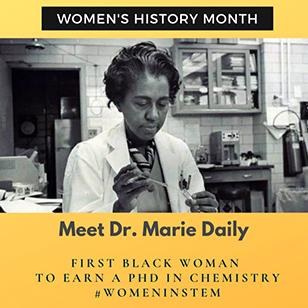
Students in the I101 course helped created the foundation for U.S. State Department social media posts.
The Informatics I101 Introduction to Informatics and Computing course at the Luddy School of Informatics, Computing, and Engineering is designed to give students a hands-on approach to understanding and using technology by teaching the basic concepts of the fields of informatics and computing.
The class also is helping the United States State Department highlight underrepresented innovators in science, technology, engineering, and math fields.
Through a class project that required students to identify an underrepresented innovator in STEM, design a survey about the innovator, create visualizations, build a website, and develop social media posts, Luddy students have provided the foundation for content for the State Department’s #STEMFirsts social media campaign.
The program is an extension of a previous collaboration between Luddy faculty and the IU Diplomacy Lab to create a social media campaign for the State Department’s Bureau of Oceans and International Environmental and Scientific Affairs.
“We were redesigning the I101 course, and we wanted a project that could give the students all the skills that we currently explore in the lab but make it cohesive with our lectures,” Professor Katie Siek said. “The IU Diplomacy Lab program had all the components, including a web component and a design component, and we could add a data component. It also could teach students the importance of diversity in STEM.”
The finished projects were turned over to the State Department, which used a highlight of Dr. Gladys West, a pioneer in the development of the global positioning system, during Black History Month in February. Dr. Marie Daly, the first black woman in the U.S. to earn a Ph.D. in chemistry whose research uncovered the relationship between cholesterol and heart health, and Dr. Lillian Gilbreth, the first industrial and organizational psychologist have already been highlighted during Women’s History Month in March with more to come.
Siek and Lecturers Chase McCoy and Logan Paul faced a challenge in scaling up the size of the program used by the IU Diplomacy Lab, which features classes of 20-30 students. I101 features much larger class sizes, but Siek, McCoy, and Paul were up to the task.
“We ended up with more than 120 groups,” McCoy said. “We had to work to scaffold it well so students could understand how what they were doing in Week One related to what they were doing in Week Two, Week Three, and so on. Then, we had to take all of that and build to a final project that could be delivered. It was a huge undertaking, but it worked out great.”
Beyond scaling the project, there were other challenges.
“We had to be clear to teach them how informatics applied to what we were doing, but then you throw in the pandemic and the asynchronous online teaching,” Siek said. “It could have been a perfect storm, but fortunately, the students responded.”
The project gave students an opportunity to learn about the various aspects of informatics, from creating visualizations to building surveys to learning how to clean data and turn it into something useful.
“They’re not going to come out of the class as Excel pros or Google Data Studio pros or Adobe XD pros,” Paul said. “But we hope that the experience in this class will give students enough pools in which to dip their toes where one will pique their interest. They can realize that there is some aspect they can pursue and explore and that they’re capable of doing.”
The State Department’s social media posts are modified versions of the various projects, but with the opportunity to have their work amplified at a federal level, the students took their efforts seriously.
“Working with the State Department added another layer to the projects,” Paul said. “The students really worked hard to produce quality results so they would look good, and IU would look good as well.”
Freshman Colin LeFevre, who is majoring in informatics and is part of the inaugural class of Luddy Scholars, came up with the campaign’s hashtag.
“The female scientists the State Department wants to highlight are incredibly talented, accomplished women who deserve every accolade they have received based purely on the merits of their work,” LeFevre said. “That they did so while in male-dominated fields only adds to the many reasons they deserve recognition.
“The I101 projects and faculty taught me a great deal about how informatics functions, and even more importantly, how I can find my own place within it. I101 gave me an excellent survey of the many skills within informatics, ranging from HTML website design to the very social media project that grew into #STEMFirsts.”
The I101 projects have created a bank of possible subjects that can be used by various organizations in the future, and the faculty leaders of the course plan to continue to expand the effort.
“We’ve continued this project for the spring semester and have made some changes in regard to the topical area,” said McCoy, who is the lead instructor for the team that teaches I101. “We’re focusing on innovators in computing and technology, and we’re encouraging them to select contemporary innovators. I’m really excited to look through all the people they select.”
Adapting the projects in the course also help to keep the content current for students and fresh for the educators.
“Informatics takes a team-teaching approach to core courses,” Siek said. “We have this core group of people in informatics who really care about this class. We’re always iterating on the course and talking about it, and it’s exciting when it takes a direction we all enjoy.”

